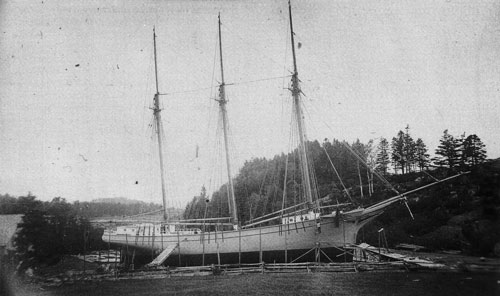B A C K T H E N
Leila Smith, the Last of East Machias

September 1890. East Machias. The schooner Lelia Smith is nearly ready for launching into a creek of the Machias River. A near copy, the Abbie O. Cole would be built on the site the following year. The two schooners were the last of at least 130 sizable vessels built at East Machias; neighboring Machias and Machiasport built at least 145 others.
The Smith and the Cole were fast and handy. Both were built by Charles Frye, master builder for Pope, Harris & Company, lumber manufacturers and dealers. Frye “modeled” other vessels for Pope & Harris, and doubtless designed these schooners, as well.
Most wooden ships were designed by carving a wooden half-hull model. The successful modeler, equipped with sharp tools, a steady hand, and a gifted eye, shaped a block of pine lifts to represent a vessel of specified tonnage, dimensions, and carrying capacity, and of a form which could be built economically and would perform well in a variety of trims and sea conditions. Often a vessel was shaped to suit the requirements of a particular trade. She should also be good looking and, when launched, float no deeper than expected. Various key “lines,” “taken off” the model and expanded, were “lofted,” or drawn, full size, on the “mold loft” floor. These drawings were transferred to molds—patterns made of boards—which guided the cutting and hewing of frame timbers.
Successful modeling owed more to art than to science, and, like other works of art, models drew close scrutiny. In 1893 a model was cut for a prospective four-master for the Sawyer Brothers, shipbuilders of nearby Milbridge. Judging by the extremely sharp turn of the Lelia Smith’s quarters, comments regarding the shape of the model’s stern suggest that it, too, was Frye’s work. The model was sent to John S. Emery, a venerable Boston shipowner and broker, and native of Sullivan, for comment. Emery graciously responded that it was the best model he had seen from Milbridge, but suggested it “be given a little quicker sheer” forward, while aft, “we should want to round her off a little under the quarter, for it turns so short a corner, it would be difficult to work on plank, and all the caulking you should do, would tend to wedge the plank off…” He also thought she would be the better if she were six inches deeper. Emery showed the model to a visiting captain interested in “getting up” a vessel, i.e., raising money from investors to build a vessel for his command:
Capt. Wyman is here today, and has looked your model over and likes it pretty well, only that he thinks the stern might be improved a little by narrowing it up a little on top, and rounding it off under the counter where the turn comes, for like others, he thinks you would have to use knees to get out so sharp a corner. He does not like the rake of the stem as well as though it rounded out a little more gracefully at the upper end, and he thinks if she could be eased a little more at light waterline in the run, she would go a little better, and still carry as much.
Captain Wyman didn’t take the bait, but the model was used for the construction of the Edna M. Champion, the first four-master built in Washington County. Her master wrote to the Sawyers after her maiden passage:
We would offer the suggestion that two feet in width be added to the next one you build, then, with the bottom as near like the Champion’s as you can get it, except making a little allowance by sharpening the run below light water to prevent the vessel going by the head. We are sure you will have attained a perfect model.
Such changes could be made in the mold loft, without the necessity of carving a new model; indeed, often the old molds could be modified.Although undoubtedly made from the same model as the Smith, the Cole measured a foot narrower, a foot longer, and several tons smaller—not only were no two wooden vessels identical, probably no vessel as built was a perfect copy of its model.
Text by William H. Bunting from A Days Work, Part 2, A Sampler of Historic Maine Photographs, 1860–1920, Part II. Published by Tilbury House Publishers, Gardiner, Maine. 800-582-1899
